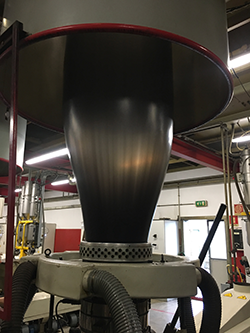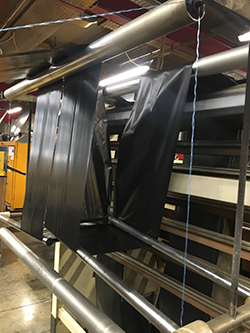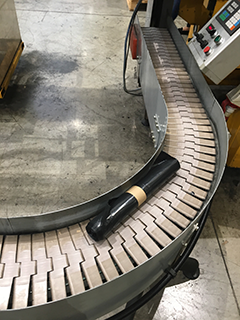Manufacturing - Comparison of materials - Thickness and dimensions
Voussert offers a wide range of garbage bags for use by professionals and communities.
Given the depth of our product range and the different manufacturing processes, at Voussert, we place great importance on helping you understand the products we sell. This is for a simple goal: to allow you to compare and make the best purchase.
What is a garbage bag made from?
For polyethylene bags, the raw material itself is obtained from the granules that are mixed and heated. The quality of the granule is crucial and it is this that will give the good quality of the bag. A mixture with too much "recycled" or poor quality material can lead to catastrophic results at the sheath level . This is generally visible in transparency in the texture of the bag, which is therefore irregular. The addition of a colorant makes it possible to obtain different colors of garbage bag depending on the use.
The sheath used for extrusion is made from an inflation and cooling operation. Extrusion is a sophisticated technique in its development that requires several years of experience in order to play on the optimal thicknesses. The technique of co-extrusion of the garbage bag where the film that will compose the garbage bag is composed of several layers superimposed on each other. The layers are extruded independently then assembled simultaneously in a tool called a die. Extrusion also applies to the biodegradable resin used in biodegradable bags. Shaping includes all the steps necessary to transform the sheath into a finished product: making the gussets, printing/marking, passing the tie, welding and pre-cutting, packaging in rolls and putting into boxes.
What material should a garbage bag be made of?
A garbage bag is made from polyethylene, which is commonly called plastic.
This plastic material is obtained by polymerization (multiplication of molecular chains) of ethylene. The molecular formula C2H4 of polyethylene is equal to 2 carbon molecules and 4 hydrogen molecules.
This material called "polyethylene" can nevertheless take several forms , which we will detail. Plastic being a source of massive pressure, alternatives now exist in bags made from biodegradable materials such as potato starch or corn starch, which are certainly even more expensive today but which no longer have any impact on the environment.
Plastic garbage bag which polyethylene?
There are two main categories of manufacturing for the garbage bag. It can be made of low density polyethylene (LDPE or LDPE) or high density polyethylene (HDPE or HDPE) .
A garbage bag is generally made from low-density polyethylene. This type of material is used for garbage bags over 50 liters for reasons of puncture resistance. These garbage bags are often used to carry heavy loads such as food or sharp and puncture-resistant objects. Another material used in the manufacture of garbage bags is high-density (HD) polyethylene. The difference between a high-density (HD) polyethylene garbage bag and a low-density (LD) polyethylene bag lies in the load resistance. Indeed, an HD garbage bag with a thickness almost half that of a LD garbage bag will offer the same load resistance. On the other hand, the puncture resistance of the garbage bag (cans, sharp objects, etc.) will be better on a LD garbage bag.
It is therefore essential to know before choosing a garbage bag what type of waste the garbage bag will have to support.
Virgin, regenerated or recycled polyethylene garbage bag?
In the basic design, raw materials remain an important element that characterizes the quality of your product. Choosing recycled or regenerated raw materials is now a must to preserve resources and the environment. Regenerated refers to a material derived from collected PE waste that, after washing, is remelted to obtain a reusable material.
Recycled refers to a premium material obtained after remelting production waste.
Finally, virgin material is a material derived from petroleum, molecular structure = C2H4.
What is a low-density polyethylene garbage bag?
The garbage bag has a shiny appearance and remains soft to the touch. The thickness of the bag varies between 30 and 80 microns in common use. This type of manufacturing gives a garbage bag resistant to perforation and beyond 45 microns it offers significant load resistance qualities.
These garbage bags are often used to store heavy loads such as food or sharp and punctured objects.
What is a high-density polyethylene garbage bag?
High-density garbage bags are recognizable by their crinkled sound. Their thickness varies between 8 and 20 microns.
They are generally used for collecting light and bulky waste such as paper and emptying bins.
The difference between a high-density (HD) polyethylene and a low-density (LD) polyethylene garbage bag is the load resistance.
In fact, an HD garbage bag with a thickness almost half that of a BD garbage bag will offer the same load resistance.
On the other hand, the puncture resistance of the garbage bag (tin can, sharp object, etc.) will be better on a BD garbage bag.
It is therefore essential to know before choosing a garbage bag what type of waste the garbage bag will have to support. If it is heavy (or light) but not sticky waste (e.g. paper, office waste, etc.), then you can choose a HD garbage bag model.
On the other hand, if the garbage bag has to deal with sharp objects (tin cans, metal, glass, etc.), then it is essential to use BD garbage bags.
How is a low-density garbage bag made?
Our factory has been recycling and using extruded low density polyethylene film since 1973 .
Our finished product is the garbage bag.
Thanks to more than 40 years of experience, we have developed a high-quality product that meets the most varied demands of a competitive and demanding European market in terms of size, thickness, color, printing, packaging, labeling, etc., thus guaranteeing customers the best flexibility and commercial availability, and offering them alternative products developed in our laboratories.
Our company controls the entire production chain, from regeneration and/or recycling to the extrusion blowing of the film constituting the garbage bag.
This allows us to constantly improve our production process and therefore our finished product.
This flexible manufacturing allows our factory to meet numerous manufacturing demands.
The garbage bag can be produced in rolls or in bulk, equipped with side gussets with the possibility of inserting a polypropylene tie, folded in C or with a drawstring tie.



Loose garbage bags, folded and packaged, can have a capacity of 500 to 1100 liters. These are generally bags intended for use as garbage container covers.
Our production lines are optimized to allow permanent control over production parameters using gravimetric buckets and automated size control in order to obtain a consistent finished product with excellent mechanical resistance characteristics .
We can customize our products to meet customer needs, by printing texts, designs, symbols or logos directly on the bags, or on the cardboard packaging with specific labels, or even closing the rolls with paper strips on which the EAN codes and/or logos in the customers' colors are printed (for large volumes).
The excellent quality of the regenerated raw material allows our factory to obtain a wide range of colors and different degrees of opacity or transparency depending on the customer's needs.
Biodegradable garbage bags: the future of waste collection
As part of the development of biodegradable materials, we are beginning to see the appearance of biodegradable or compostable garbage bags made from potato starch or corn starch.
Voussert offers a range of biodegradable garbage bags , made from 100% biodegradable/compostable plant materials , allowing the collection of all types of waste intended for composting (organic fermentable fraction of household waste, green waste). The biodegradable garbage bag has two types of closure: either traditional with a plant tie, or with biodegradable sliding ties. The garbage bag is available in several liters depending on its use (from type 10 to 20 for organic fermentables and from type 50 to 110 for the green waste fraction). A large printing/marking area allows the communication of collection instructions. The garbage bag meets OK Compost and VGS standards. Liners for rolling bins made of biodegradable material are also available.
How to choose the dimensions and capacities of the garbage bag?
Voussert offers a wide range of garbage bag volumes ranging from 100L to 170L for standard sizes, and from 5L to 50L for smaller bins.
| Volume | End use |
| 5L, 10L, 20L | Sanitary waste bins |
| 30L | Office trash cans, home kitchen |
| 50L, 100L, 130L | High traffic areas (buildings, canteens, train stations, airports, etc.) |
| 110L | Street bag holder and cleaning trolley |
| 120L to 1100L | Protective cover for wheeled city container (2 and 4) |
How do I check the price of my garbage bag?
Your bag is characterized by its material, but also its dimensions and thickness. Very often, the volume announced is not reliable data as such because a manufacturer may choose to shorten a bag (for example) to reduce its cost.
The important data if you want to compare two products of equivalent material are the dimensions (to be measured) as well as the thickness and then weigh this bag on a scale.
The calculation formula is as follows:
Weight of your bag = Half perimeter X 2 X Height X Molecular density X Thickness
The molecular density of LDPE is 0.92 on average
The molecular density of HDPE is 0.95 on average
The half perimeter corresponds to the opening of the bag fully unfolded, gussets included.
With these elements you should now be able to really understand what you are buying and compare...
The garbage bag container cover with wheels and rolling bin
One range of garbage bags that is important to detail is that of container liners . Also called container covers, these garbage bags have the function of protecting wheeled waste containers (2 or 4 depending on the size) that we find in our cities and in our commercial areas. These covers are generally of a low thickness because they are intended to protect and not to carry loads.
Yellow Dasri hospital bag
The hospital bag range must meet a specific standard for infectious waste. The NFX 30-501 standard is the reference standard. A Dasri garbage bag must be incinerable and limit harmful toxic emissions into the atmosphere. The bag must be closed with a drawstring. The fill limit must be indicated to prevent overfilling or improper closure of the garbage bag. Our Dasri bags are available in sizes from 15L to 110L and are made in France.